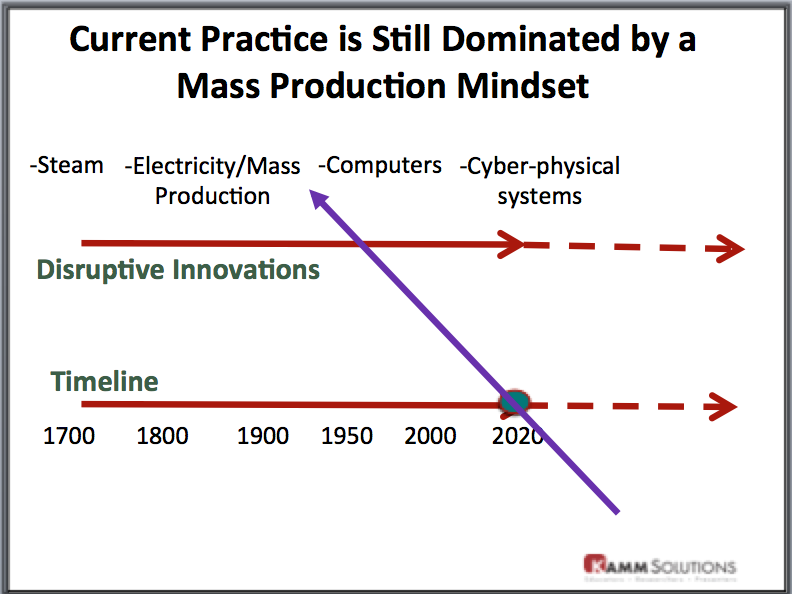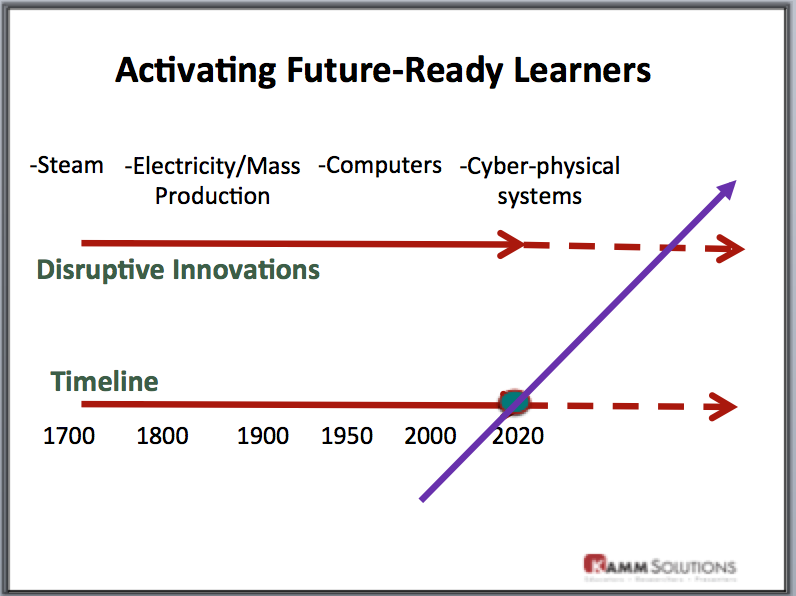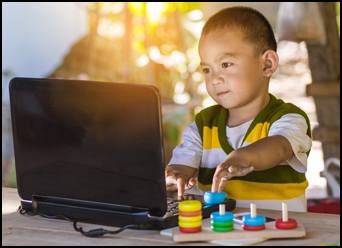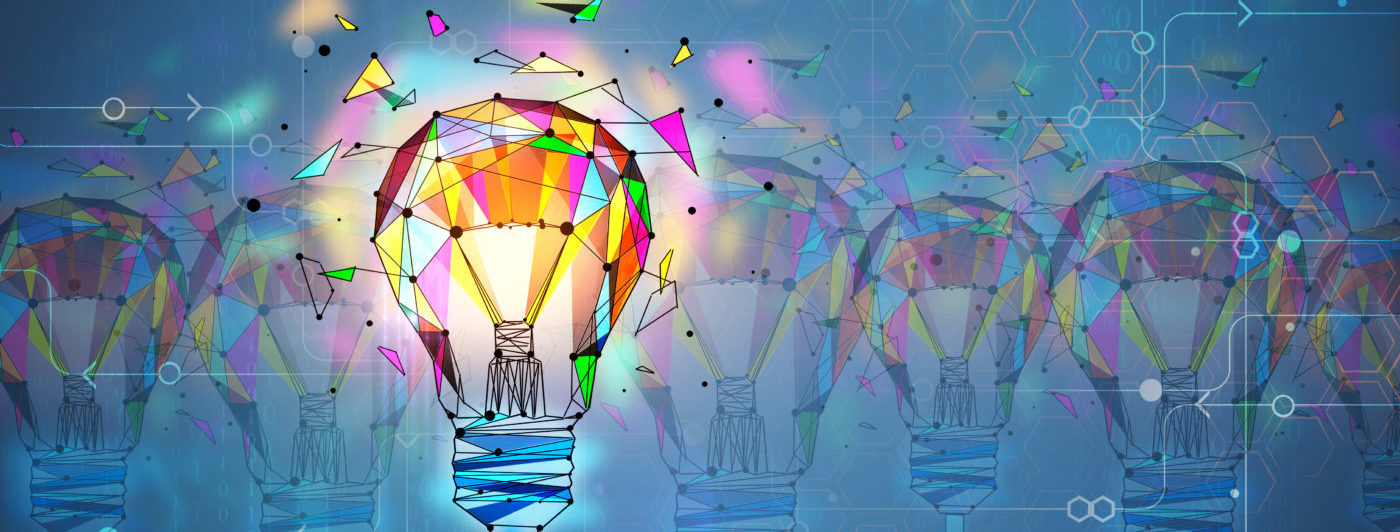Activating Future-Ready Learners
Dear TUSD Educators,
This webpage includes rich resources that we will use during our session and that you can refer to later as you build learning experiences for your students. If you would like additional resources, please let me know, and I will do my best to support you.
The following links provide an overview of who we are and what we do:
If you would like to contact me, my email is conniekamm@kammsolutions.com, and my cell number is 1-602-524-0282.
Warm regards,
Connie
Section 1: Curriculum and Instruction Workshops

Cocreating a Preferred Future
Linda Darling Hammond, a world renown leader in education, notes that in order to be prepared for the future, today’s students “need to acquire well-developed thinking, problem solving, design, collaboration, and communication skills. Students also need to be able to find, evaluate, synthesize, and use knowledge in new contexts, and produce research findings and solutions.” The following resources support virtual workshops that concentrate on activating future-ready learners through dynamic curriculum development and engaging instructional practices.
Curriculum and Instruction Retreat (January 14, 2021)
Agenda: Activating Future-Ready Learners
- Examine the Future World of Work.
- View a video from Scotland:Work is About to Change Forever.
- Discuss Transversal Competencies a TUSD Learning Diagram.
- Determine the criteria you would include in a Framework to Guide Future-Focused Curriculum Development?
- Complete Group 1: Framework to Guide Future-Focused Curriculum Development.
- Complete Group 2: Framework to Guide Future-Focused Curriculum Development.
- Explore Tucson Unified’s Vision, Mission, Strategic Goals and the Strategic Planning Framework.
- Examine a DRAFT of the Tucson Unified Strategic Plan.
- View the Strategic Plan Framework, phases 1-3.
- View and discuss the video on Citizen Science.
- Determine possible C&I commitments under Strategic Goals 1-3.
- Complete Group 1: Strategic Goals and Commitments.
- Complete Group 2: Strategic Goals and Commitments.
Session 1: Virtual Workshop (Feb. 16, 2021)
Session 1: Co-Creating a Curriculum Framework to Support Future-Ready Learners
TUSD Curriculum and Instruction, Feb. 16, 2021
- Discuss today’s agenda and the webpage (password: tusdci).
- Participate in breakout session 1: Now and Tomorrow – Creating a Preferred Future.
- Select a quote and respond to the question/prompt following the quote (handout).
- Discuss the implications in the quotes in regard to changes in curriculum and instruction.
- Examine Classroom Practices to Prepare Future-Ready Learners.
- View a video on The Future of Work.
- Revisit Transversal Competencies (Slides) (Article).
- Examine the Universal Design for Learning Diagram.
- View classrooms in action.
- Record the teaching and learning practices you would like to see in all TUSD schools (Download Word Doc).
- Participate in breakout session 2: What did you Observe? (Group 1 Google Doc; Group 2 Google Doc)
- Engage in breakout session 3: Create Categories for the TUSD Future-Focused Curriculum Framework
- Explore a beginning framework design – to be modified and published on an interactive Website (Group 1 Google Doc; Group 2 Google Doc)
- Suggest categories and components
- Consider the following resources:
- Tucson Unified Strategic Plan,
- Culturally Responsive Teaching Manual (With SPARKS),
- TUSD curriculum documents, and
- Literature reviews (See Section 3 this Webpage, Tab 3, Interactive Literature Review Tables to Support Curriculum Development).
- Share suggestions for categories and components with the larger group.
- Complete a closing questionnaire.
Session 1a: Virtual Workshop for New Team Members (March 24, 2021)
Session 1a for New Team Members: Co-Creating a Curriculum Framework to Support Future-Ready Learners
Agenda, March 24, 2021
- Discuss today’s agenda and the webpage (password: tusdci).
- Participate in breakout session 1: Now and Tomorrow – Creating a Preferred Future.
- Select a quote and respond to the question/prompt following the quote (handout).
- Discuss the quotes’ implications regarding changes in curriculum and instruction.
- Examine the future world of work and the competencies needed to be prepared for the future.
- View a video on The Future of Work.
- Explore Transversal Competencies (Slides) (Article).
- Examine the Universal Design for Learning Diagram.
- Explore the current draft of the Tucson Unified Strategic Plan and the three-phased diagram of the Strategic Plan in operation.
- View classrooms in action and participate in breakout session 2: A Tale of Two Schools (Group 1 Google Doc; Group 2 Google Doc).
- Engage in breakout session 3: Create Categories for the TUSD Future-Focused Curriculum Framework.
- Explore a beginning framework design – to be modified and published on an interactive Website (Group 1 Word Doc; Group 2 Word Doc)
- Consider the following resources:
- Culturally Responsive Teaching Manual (With SPARKS),
- TUSD curriculum documents, and
- Literature reviews (See Section 3 this Webpage, Tab 3, Interactive Literature Review Tables to Support Curriculum Development).
- Share suggested additions to the Framework with the larger group.
- Discuss the April 7, 2021, Curriculum Framework Team Meeting: Sign up for the area that interests you.
- Complete a closing questionnaire.
Session 2: Virtual Workshop (April 7, 2021)
Session 2: Creating a TUSD Curriculum Framework for Future-Ready Learning
Session 2: April 7, 2021 (PDF of Agenda)
- Welcome C&I Framework Team and discuss the agenda
- Sign up for the Framework Area on which you would like to focus (Google Sign-Up)
- View The Adaptable Mind.
- Engage in Breakout Session 1: Select a statement from The Adaptable Mind and provide an example of what this idea could look like in action.
- Continue examining the TUSD Curriculum Framework for Future-Ready Learning.
- View videos from Linda Darling-Hammond on future-focused education in action and determine what needs to be added to the current draft of the Framework.
- Review TUSD curriculum documents and determine what needs to be added to the current curriculum and what needs to be included in the Framework.
- Participate in Breakout Session 2: Determine What May Need to be Added to the Framework (Group 1, Group 2, Group 3). Consider Instructional Practices MTSS, Blended/Flipped Classroom.
- Co-create in Breakout Session 3: Concentrate on one specific focus area and more fully develop the framework for that area.
- Examine Problem-Based Learning (Group 1):
- Interactive Literature Review
- Video: Michigan Study
- Video: Eva Ryder’s Geometry Class (5-week, problem-based project)
- Address Personalized Learning (Group 2):
- Explore Social and Emotional Learning (Group 3):
- Interactive Literature Review
- Video: SRCS 3rd Grade Class Supports Local Nonprofits
- Video: Making Students Feel Safe
- Edutopia Resources on Social and Emotional Learning
- Examine Problem-Based Learning (Group 1):
- Share Groups 1-3 sections with whole group. Critique the Framework. What works well? What needs to be improved?
Session 3: Virtual Workshop (April 21, 2021)
Session 3: Focusing on the Framework for Future-Ready Learning
April 21, 2021 (PDF of Agenda)
Part 1:
- Participate in a Warm-up: The Power of Imagination.
- Engage in Breakout Session 1: Prompt.
Part 2:
- Examine the Revised Google Doc Framework.
- Explore TUSD Instructional Resources and Current Curriculum Documents:
Part 3:
- Work on Specific Framework Areas in Breakout Session 2:
- Group 1: Personalized Learning (PL)
- Group 2: Problem-Based Learning (PBL)
- Group 3: Social and Emotional Learning (SEL)
- Present Framework Section to the Larger Group for Feedback.
- Critique the Framework Document.
- Homework: Complete Your Current Section.
- Determine the New Sections to Complete – Questionnaire:
- Formative Learning
- Blended Learning
- Asset-Based
- Multi-Tiered Systems of Support
- Culturally Responsive Teaching and Learning
- Practices that Support Equity, Diversity, and Inclusion
- Community School/Apprenticeship Learning Opportunities
- Explicit Direct Instruction
- Standards-Based Teaching and Learning
Session 4: Virtual Workshop (May 5, 2021)
Session 4: Co-Creating The Framework to Guide Future-Ready Learning (PDF)
(Purpose: To Guide Curricular Revision and Development)
May 5, 2021
Part 1: Discuss the Framework
- Participate in a warm-up: Define the purpose of a framework.
- Engage in Breakout Session 1: Handout.
Part 2: Explore the Future World of Work
- View the video, The New Realities of Work.
- Answer the following questions in Breakout Session 2: Handout
- What are the main points from the video regarding the demands of the future world of work?
- Will the areas selected for The Framework to Guide Future-Ready Learning better prepare TUSD students for the future? Please explain:
-
-
- Problem-Based Learning;
- Personalized Learning;
- Social and Emotional Learning;
- Asset-Based Instruction;
- Culturally Responsive Teaching and Learning; and
- Equity, Diversity, and Inclusive Practices.
-
-
- Why is The Framework to Guide Future-Ready Learning important for TUSD?
- How can it be most effectively implemented?
Part 3: Complete the Framework
- Discuss the feedback from April 21, 2021.
-
- Review an example of the revised template for the framework focus area on formative learning.
- Critique the revised template.
- Continue your work in Breakout Session 3a on the following focus areas from The Framework to Guide Future-Ready Learning:
-
- Use the April 21, 2021 Template:
- Group 1: Personalized Learning (PL),
- Group 2: Problem-Based Learning (PBL), and
- Group 3: Social and Emotional Learning (SEL).
- (OR) Use the May 5, 2021 Template:
- Group 1: Personalized Learning (PL),
- Group 2: Problem-Based Learning (PBL), and
- Group 3: Social and Emotional Learning (SEL).
- Use the April 21, 2021 Template:
- Present framework sections to the larger group for feedback.
- Engage in Breakout Session 3b. Determine the connection of your framework area to TUSD’s instructional resources and curriculum documents:
- Discuss and sign-up for focus sessions on May 19, 2021.
OR (Depending on our progress)
- Complete the homework: Please finalize your current section.
Session 5: Small Group Work (May 19, 2021)
Session 5: Co-Creating The Framework to Guide Future-Ready Learning
Small Group Workshops, May 19, 2021 (PDF)
- Discuss the feedback from April 21, 2021.
-
-
- Discuss questions and guidelines for the revised template.
- Review an example of the revised template for the framework focus area on formative learning.
-
- Continue your work on The Framework to Guide Future-Ready Learning:
-
- Transfer work from the April 21, 2021 Template:
-
-
- Group 1: Personalized Learning (PL),
- Group 2: Problem-Based Learning (PBL), and
- Group 3: Social and Emotional Learning (SEL).
- Use the May 5, 2021 Template:
- Group 1: Personalized Learning (PL),
- Group 2: Problem-Based Learning (PBL), and
- Group 3: Social and Emotional Learning (SEL).
- Record on To Do List
- Group 1: Personalized Learning To Do List,
- Group 2: Problem-Based Learning To Do List, and
- Group 3: Social and Emotional Learning To Do List.
-
- Consider TUSD’s instructional resources and curriculum documents:
Session 6: Small Group Work (May 26, 2021)
Session 6: Co-Creating The Curriculum Framework to Activate Future-Ready Learning
Small Group Workshops, May 26, 2021 (PDF of Agenda)
- Examine Questions and Guidelines.
- Continue your work on The Framework to Guide Future-Ready Learning. Use the following templates:
-
- Group 1: PL Revised Template
- Group 2: PBL Revised Template
- Group 3: SEL Revised Template
Record tasks your to-do list:
-
- Group 1: PL To-Do List
- Group 2: PBL To-Do List
- Group 3: SEL To-Do List
- Consider TUSD’s instructional resources and curriculum documents:
Session 7: Small Group Work (June 15 and 17, 2021)
Session 7: Co-Creating The Curriculum Framework to Activate Future-Ready Learning
Small Group Workshops, June 15 and 17, 2021 (PDF of the Agenda)
- Discuss TUSD’s MTSS Implementation: Lit Review on MTSS
- Review the MTSS links from Heidi: ( MTSS Handbook_2019, MTSS Process Flowchart Secondary, MTSS Process Flowchart Elementary)
- Examine Questions, Guidelines, and Examples.
- Continue your work on The Framework to Guide Future-Ready Learning. Complete the following templates:
-
- Group 1: PL Revised Template
- Group 2: PBL Revised Template
- Group 3: SEL Revised Template
Record tasks your to-do list:
-
- Group 1: PL To-Do List
- Group 2: PBL To-Do List
- Group 3: SEL To-Do List
5. Resources to Review for New Topics (Sign-Up Sheet)
Session 8: In-Person Workshop (June 24-25, 2021)
Session 8: Co-Creating The Curriculum Framework to Activate Future-Ready Learning
In-Person Workshop, June 24-25, 2021
- Examine Updated Questions, Guidelines, and Examples.
- Review tips for Researching Articles on Google.
- File resources on SharePoint.
- Continue your work on The Framework to Guide Future-Ready Learning. Complete the following templates:
-
- Group 1: PL Revised Template
- Group 2: PBL Revised Template
- Group 3: SEL Revised Template
- Group 3 New Template: SEL Revised Template
Record tasks your to-do list:
-
- Group 1: PL To-Do List
- Group 2: PBL To-Do List
- Group 3: SEL To-Do List
6. Resources to Review for New Topics (Sign-Up Sheet)
Session 9: Virtual Workshop (September 7, 2021)
Session 9: Co-Creating the TUSD Curriculum Framework To Activate Future-Ready Learning
Virtual Workshop (September 7, 2021) PDF
PART 1: Review and Revise Completed Work
- Engage in a warm-up activity: Connect What You Should Know About Your Brain with the Six Components in TUSD’s Curriculum Framework for Future-Ready Learning.
- Review the website for the Framework with Sally Jacunski.
- Examine Questions, Guidelines, and Examples.
- Review the work completed during the workshop on June 24-25, 2021. Make any necessary revisions prior to putting PL, PBL, and SEL tables on the website. Submit your final draft to conniekamm@kammsolutions.com.
- Group 1: Final PL Table (Docx)
- Group 2: Final PBL Table (Docx)
- Group 3: Final SEL Table (Docx)
Refer to Google tables as necessary.
-
- Group 1: PL Revised Table
- Group 2: PBL Revised Table
- Group 3: SEL Revised Table
PART 2: Cocreate New Templates and Plan for Next Steps
- Review tips for Researching Articles on Google.
- Refer to file resources on SharePoint.
- Review Resources for New Topics (Sign-Up Sheet).
Group 1
Group 2
Group 3
- Determine a template to embrace the six areas in the Framework (See section 3, Tabs 1 & 2).
- Create a graphic design to connect the six areas in the Framework.
Videos To Use in the Framework
- String-Theory Schools Citizen Science
- Two Rivers Charter School Problem-Based Learning
- Two-Rivers Charter School Critique Protocol (Formative Learning Practices)
- The Future of Work
- The Adaptable Mind
- Linda Darling Hammond on PBL
- Arts Integration at Two-Rivers Charter School
- Making Classrooms More Inclusive for Multilingual Learners, An Asset-Based Approach (New)
- Conversations About Social Justice (New)
- Making the Space For Your Students’ Perspectives (New)
- Windows and Mirrors: Learning About Differences – and Belonging – Through Books (New)
- Equity: Getting All Students to Participate (New)
- Let Young People Lead With Their Identity (New)
- Inquiry-Based Learning: From Teacher-Guided to Student-Driven (New)
- Six Ways to be an Anti-Racist Educator (New)
- Why Project-Based Learning Outperforms Traditional Instruction (New)
- Habits, Community, and Culture: Laying the Foundation for Emotional Intelligence (New)
Literature Review Tables
Please Check the Following Interactive Literature Review Tables Created by the Kamm Solutions’ Team.
-
- Multi-Tiered Systems of Support (Includes Trauma-Informed Practices)
- Overcoming Implicit Bias
- Equity and Opportunity: Closing the Achievement Gap
- Guidelines for Problem-Based Learning
- Personalized Learning and Competency-Based Education
- Whole Child (Social and Emotional Learning)
- Stimulating Creativity
- Creating a School Culture Based on Trust
- Learning Through Inquiry
- Equity and Inclusive Practices (ELL and Special Education)
- Table of Contents to Multiple Literature Review Tables (Note page 3)
- Guidelines on Effective Feedback
- Identifying, Recruiting, and Retaining Gifted Students
TUSD Vision, Mission, Values, and Strategic Goals
Section 2: Embracing Transversal Competencies
This section contains resources about Transversal Competencies, which are are abilities, mindsets, and qualities that students need to develop in order to be well prepared for future careers and productive global citizenship. Consider the following Transversal Competencies:
- Thinking Dynamically: Curiosity, creativity, innovation, and critical thinking
- Knowing Oneself: Self-efficacy, mindfulness, brain awareness, growth mindset, initiative, and resilience
- Caring About Others: Intercultural awareness, openness, and empathy for others
- Engaging With Others: Collaboration, communication, social skills, conflict resolution, and emotional intelligence


1. Activating Future-Ready Learners in a World of Exponential Change
The following resources offer keen insights into the exponential change our world is experiencing in this era of the Fourth Industrial Revolution. Learn about the future world of work, the connections between industries and nations, the challenges posed by the practices of digital giants, the latest advancements in cyber-physical systems, and the concept of transversal competencies. Select at least three sources that interest you from the following resources. Be prepared to discuss your observations with others during both small and large group activities in our next session. Please note the following questions:
- Please summarize the main points from the resources you selected. What are the implications of these main points for K-12 education (teaching, learning, and leading)?
- To ensure that your students and staff are future ready, where do you see your greatest need for growth in teaching and learning? Why have you selected this area? How can this area for growth be supported through a future-focused curriculum framework?
Videos
- The Great Reset (Video on our opportunity to reset the future)
- The Future World of Work (Brief video from What Schools Could Be)
- The New Realities of Work (Deloitte presents seven realities of the future of work that people can act on today)
- Sophia the Robot (An interview with Sophia the Robot at Brain Bar in Budapest, 2018)
- Young People Reimagine Education for the 21st Century (Brief video)
- Voices of Youth on the Future of Work (Brief video)
- The Future of Education (Video featuring an insightful panel discussion )
- Future of Work: 5 Top Insights from Davos Experts (2020) (Video featuring a panel of industry leaders meeting in Davos, Switzerland)
- What is the Fourth Industrial Revolution? (Video from The World Economic Forum)
Articles and Reports
- The Robots are Coming for Phil in Accounting (A New York Times article)
- The Future of Work After COVID-19 (A new report from McKinsey & Company)
- What Building Back Better May Mean for Education and Job Training in the United States (Blog from Mark Tucker)
- Seventeen Ways Technology Could Change the World by 2025 (Article From the Pioneers of Change Summit )
- Not All That Glitters is Gold (An research-based article about technology’s impact today and tomorrow)
- The Future of Jobs, 2020 (A Report from The World Economic Forum)
- What’s Next for Remote Work (Article from McKinsey & Company)
- Re-Finding the Future (Blog from The Futurist)
- 9 Building Blocks For a World-Class Education System (Summary of Marc Tucker’s Work)
- How to Deal With the Complexity of Future Cyber-Physical Systems (Scholarly journal entry from Designs)
- Critical Thinking is the Most in Demand Soft Skill (Brief article)
- Standardization Broke Education: Here’s How We Can Fix Our Schools (Brief article by Sir Ken Robinson)
- Five Things to Know About the Future of Jobs (Brief article)
- The Changing Nature of Work (A thorough report from The World Bank Group, 2019)
- An Overview About Transversal Competencies (Part 1 of an article from Kamm Solutions)
- Global Shapers (A worldwide organization of young people, includes video link)
- Global Shapers’ Survey (Results from an international survey focused on the perceptions of young adults)
- Skills for Your Future (Webpage with series of short articles)
- The Age of Surveillance Capitalism (An interview with Dr. Soshanna Zuboff, includes video link)
- Here’s the Real Trouble With Tech (An article from Yale’s Magazine, The American Prospect)
- Reimagining Workforce Development (A recent report from the Rand Corporation) Plus an Overview of the Rand Report)
2. Thinking Dynamically
Thinking Dynamically: Curiosity, Creativity, Innovation, & Critical Thinking
- Kamm Solutions’ Interactive Literature Review Table
3. Knowing Oneself
Knowing Oneself: Formative Learning, Mindfulness, Growth Mindset, Brain Awareness, & Initiative
- Videos
- Carol Dweck on Growth Mindset (Video)
- Judy Willis on The Science of Learning (Video)
- Angela Lee Duckworth on Grit (Video) Note how grit is connected to formative learning and a growth mindset.
- Kamm Solutions’ Interactive Literature Review
4. Caring About Others
Caring About Others: Intercultural Awareness, Openness, and Empathy for Others
- Video
- Kamm Solutions’ Interactive Literature Review Tables
5. Engaging With Others
Engaging With Others: Collaboration, Communication, Social Skills, Conflict Resolution, and Emotional Intelligence
- Videos
- Kamm Solutions’ Interactive Literature Review
Section 3: Preparing Future-Ready Learners
 The world is changing rapidly and so must the way we educate students. The following resources are designed to support the development of units and lessons that prepare students to be ready for global citizenship and the future world of work.
The world is changing rapidly and so must the way we educate students. The following resources are designed to support the development of units and lessons that prepare students to be ready for global citizenship and the future world of work.
1. Collaborative Curriculum Design: A Future-Focused Model
Collaborative Curriculum Design – A multidisciplinary, problem/solution-based curriculum model that engages students, closes the achievement gap, builds social and emotional awareness, improves executive function, and ensures learning gains for all. Note the following general information about this design model:
- Overview of Collaborative Curriculum Design
- A Link to a Webpage About Collaborative Curriculum Design
- A Brochure About Collaborative Curriculum Design
Unit Design Templates – Each district engages in the design process, establishing the template, the platform, and the professional learning experiences that are necessary to support unit development and implementation. The following templates are examples used to guide district decisions.
- CCD Unit Template (PDF)
- Directions for Completing the CCD Unit Template
- The Collaborative Curriculum Unit Development Guide to Use for Feedback
Unit Template in Segments
2. Future-Focused Multiday Learning Experiences
A Future-Focused, Multiday Learning Experience (Within a Unit of Study)
- Template for a Multi-Day-Learning-Experience (PDF)
- Template for a Multi-Day-Learning-Experience (DocX)
- Directions for Multi-day Learning Experience (PDF)
- Math Example (PDF)
- Template Adapted for the HyFlex (Concurrent Classroom) Model
The following extended face-to-face lesson (3-5 hours) on Leonardo DaVinci can easily be transferred to a virtual lesson. Note the following resources:
- Webpage (Password: leonardo)
- Progression for Leonardo Learning Experience
- Slides
3. Interactive Literature Review Tables to Support Curriculum Development
Please Check the Following Interactive Literature Review Tables Created by the Kamm Solutions’ Team.
-
- Table of Contents to Multiple Literature Review Tables (Note page 3)
- Multi-Tiered Systems of Support
- Equity and Opportunity: Closing the Achievement Gap
- Guidelines for Problem-Based Learning
- Personalized Learning and Competency-Based Education
- Whole Child (Social and Emotional Learning)
- Overcoming Implicit Bias
- Stimulating Creativity
- Creating a School Culture Based on Trust
- Writing to Learn in Math
- Increasing Literacy
- Guidelines for Opinion and Argumentative Writing
- Guidelines for Informative Writing
- Guidelines for Narrative Writing
- Learning Through Inquiry
- Identifying, Recruiting, and Retaining Gifted Students
4. Formative Learning
Formative Learning Resources
- Guidelines on Effective Feedback
- Sample Student Goal Setting Template 1
- Sample Student Goal Setting Template 2
- Student Self-Reflection and Goal Setting Form from Allison Daniels (3rd grade, CVUSD)
- Digital Tools that Support Formative Learning
- Link to Webpage on Formative Learning
- Course on Formative Learning: Grit, Growth and Formative Learning
5. Supporting English Language Development
Section 4: Resources to Support Virtual Learning
 The following resources were create to support MSD educators in their work with online and in-person learners. Several of the agendas that were used during workshops are copied below. Please note that these agendas contain links to helpful documents.
The following resources were create to support MSD educators in their work with online and in-person learners. Several of the agendas that were used during workshops are copied below. Please note that these agendas contain links to helpful documents.
1. How to Make PBL a Reality in a Distance Learning Environment
Jigsaw this Blog: http://www.spencerauthor.com/pbl-distance/
2. Literature Reviews and Resources for Supporting Successful Virtual Learning
4. Interactive Digital Tools and Platforms
- Create a HyperDoc: Learning How to Create and Implement HyperDocs.
- Explore Edpuzzle. See Edpuzzle tutorials 2020. Sign up at https://edpuzzle.com.
- Examine Flipgrid. Here is a video on How to Use Flipgrid.
- Review the Padlet Gallery.
- View the Nearpod Library. Check out the “How-to” Videos.
- Search resources on Listenwise.
- Engage with Newsela.
- Select another digital tool to implement: Seventy-Five Digital Tools to Support Formative Learning.
5. ISTE Resource on Virtual Learning
Section 5: Collaboration, Leadership, and Awareness-Based Change
 Peter Druker, a well-known management consultant, educator and author, observed, “The greatest danger in times of turbulence is not the turbulence. It is to act with yesterday’s logic.” Perhaps a more future-focused approach to implementing and sustaining change today can be found in awareness-based change.
Peter Druker, a well-known management consultant, educator and author, observed, “The greatest danger in times of turbulence is not the turbulence. It is to act with yesterday’s logic.” Perhaps a more future-focused approach to implementing and sustaining change today can be found in awareness-based change.
1. Engaging in Change
1. Posters to Consider As You Contemplate Change
- Collaborative Teams Poster
- Strategic Plan Poster
- Curriculum Poster
- Evaluation Poster
- School Improvement Poster
2. Articles on Change
- Research_To Get People to Embrace Change, Emphasize What Will Stay the Same
- The Power of Listening in Helping People Change
- Force Field Analysis
- Michael Fullen on Change Theory
3. Theory U – Awareness-Based Change
- Two-page Synopsis:
- Chapter 1 of Leading From an Emerging Future:
2. Implementation and Professional Learning Guidelines
Consider the following guidelines on implementation and professional learning:
3. The Learning Leader: Articles & Studies
There are millions of articles and books on leadership and thousands of leadership theories. After careful consideration of thought-leaders’ theories, a heightened awareness of your community, and deep self-reflection, you will determine the qualities, mindsets, and actions that make you the effective leader you want to be.
Articles and Videos
- Is Yours a Learning Organization
- How Fearless Organizations Succeed
- Interview: The Fearless Organization, Encouraging Voice (Amy Edmondson)
- How Leaders Ask for Feedback No One Wants to Give
- Why Leaders Who Listen Achieve Breakthroughs
- What Everyone Gets Wrong About Change Management
- Turning Leadership Potential Into Success
- If you Aspire to Be a Great Leader, Be Present
- Bringing-Schools-Back-to-Life
- Leadership for Emergence- Exploring Organizations Through a Living Systems Lens
- A Warrior for the Human Spirit
- Developmental Leadership
- Uncovering The Blind Spot of Leadership
- Eleven Leadership Lessons from Abraham Lincoln
- The Dalai Lama on Leaders
- Three Elements of Trust
- The Feedback Fallacy
- Leadership is a Conversation
- Positive Work Culture
- Good Leaders are Good Learners
- Becoming a Well-Rounded Leader
- The Power of Listening in Helping People Change
- Mastering the Social and Emotional Side of Leadership
- The Most Important Leadership Competencies
- Let Go and Lead (Video with Meg Wheatly)
- The Puzzle of Motivation (Video with Daniel Pink)
- Why Good Leaders Make You Feel Safe (Video with Simon Sinek)
- Summary of Dare to Lead by Brene Brown
Determine a Plan for Continuous Growth
4. Tools for Collaborative Inquiry That Strengthen Team Dialogue

